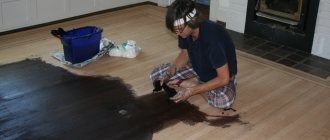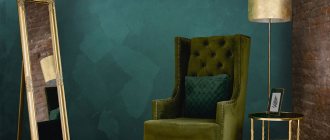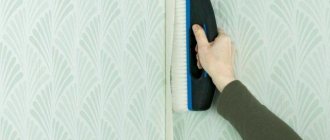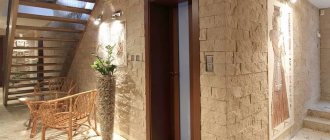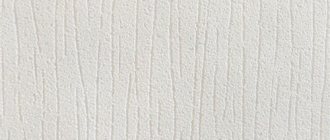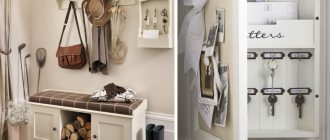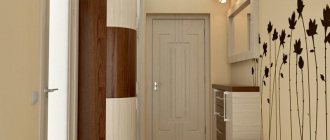How do apartment owners in Russia decorate the hallway and corridor? As a rule, these areas have small, if not tiny, areas. Since the hallway almost immediately continues with a corridor, people logically reason that the same finishing is required. And they choose the most practical types of wallpaper - washable, vinyl. That is, those that are not afraid of dirt and random mechanical impacts. However, this approach is fundamentally wrong.
From the perspective of an experienced designer, there are several focal points. It is on them that the eye falls first. Such areas require attention and careful finishing. The remaining walls can be left as background walls so as not to overload the small space.
How to make renovations in the hallway and corridor at the highest level, while saving money? What nuances should you pay attention to when finishing? We'll tell you!
Why wallpaper for the hallway and corridor?
Let's highlight 5 advantages of using wallpaper in the hallway.
- The choice of wallpaper colors and prints is huge. By combining canvases of different shades, or wallpaper and other finishing materials, it is easy to zone the area of the hallway and living room.
- Wallpaper does not take up valuable centimeters of space in a narrow corridor. And at the same time, they can visually expand the walls if you combine colors correctly.
- Dense textured wallpaper will hide minor defects in the walls of an old house.
- Wallpaper sheets are easy to glue and can be quickly replaced if necessary.
- Among the variety of wallpaper materials, you can choose a universal one for yourself - one that is easy to clean, matches the overall style of your home, and will retain its aesthetic qualities for a long time.
- High-quality photo wallpaper on the wall can significantly refresh your interior without major financial investments.
Let's talk in more detail about the choice of paintings.
Features of choice
In corridors where there is little natural light, it is better to choose combined wallpaper. Along the bottom of the wall there is a darker finish, and in the upper part a light tone is used. To avoid seeing the unsightly joint between the wallpaper, it can be hidden under the border to match one of the parts of the wall or a contrasting shade. The stains on the dark part of the walls are not so visible, but the light top will visually expand the space, making it lighter.
Covering the cold spectrum (blue, pale blue, mint, pearl gray) visually increases the space; such wallpaper is especially suitable for decorating a narrow corridor in an apartment. If the hallway is very large, warm and darker colors will visually make it smaller, making it more comfortable. You can visually make a room smaller with the help of large ornaments on the walls.
Advice! A hallway that is too long can be visually divided into two smaller parts by using wallpaper of different colors. The joint can be hidden by simulating columns or an arched passage, so the effect will become more noticeable.
If you wallpaper not only the walls of the hallway, but also the ceiling, this will create an interesting effect of an elongated space. Instead of wallpaper, you can use paint of the same color to decorate the ceiling. What wallpaper design for the hallway is relevant in 2022 can be seen in the selection of photos below.
Which wallpaper to choose: types, their advantages and disadvantages
Paper wallpaper in the hallway is, of course, already a classic.
However, there are new varieties of such canvases, stylish, practical, specifically for the corridor - for example, two-layer, with foil trim.
Pros of all paper wallpapers
- Very large color palette (compared to more exotic ones)
- Availability of choice: among canvases of any price category you can choose the desired color
- Environmental friendliness
Minuses
Paper wallpaper, even two-layer, is inferior to other canvases in terms of service life.
Conclusion
Opting for paper wallpaper is useful if you plan to update the interior of the hallway no later than in 5-7 years.
Textile wallpaper is a marker of a chic hallway in an oriental, palace or classic style.
Such canvases are associated with expensive interiors from old paintings.
Their main advantage
If you choose the right colors and place accents, you can create a cozy, interesting environment using fabric wallpaper.
Minuses
- Textile wallpaper is the least practical and therefore least suitable for the corridor. After all, fabrics attract dust, quickly fade and wear out.
- Moreover, such canvases belong to the expensive segment.
Conclusion
In general, you should only purchase textile wallpaper if the chosen style requires it and if you are going to update the decor for a short time.
Vinyl wallpaper is the most practical of the new types of wallpaper.
These are dense canvases that are designed primarily for passage areas - corridors and hallways.
The top layer of this wallpaper - PVC or vinyl - is not scratched or damaged and retains its original appearance for a long time. Their base can be paper or non-woven.
Advantages of vinyl wallpaper
- Vinyl wallpaper is washable wallpaper (!)
- They have a long service life - up to 20 years
- These wallpapers have the largest selection of textures: there are smooth models, embossed, foamed, and with a plaster texture
- At the same time, their textures are dense and hide minor flaws on the walls.
- Separately, it is worth mentioning about structural vinyl wallpaper on a non-woven basis: they can be repainted repeatedly, maintaining the relief pattern
- When gluing canvases with a non-woven base, it is enough to coat the wall with glue
Disadvantage of this wallpaper
He is alone. The vinyl layer does not allow air to pass through and releases a dangerous substance - formaldehyde. For this reason, they are recommended only for non-residential rooms and corridors.
This drawback is partially eliminated in canvases with a porous, “foamed” surface. They are safer.
Conclusion
Vinyl-coated canvases are versatile, but not environmentally friendly. They can be used without harm to health, but only in two cases:
- if the hallway is well ventilated
- or if the wallpaper itself has an improved porous structure.
Non-woven wallpaper is distinguished separately
These include fabrics with a non-woven base and vinyl coating, and homogeneous non-woven fabrics.
Their advantages
- These canvases have the same advantages as vinyl ones
: they hide imperfections in the walls and can be used for painting - In addition, non-woven fabric has a pleasant velvety texture that is reminiscent of textile wallpaper
- Non-woven wallpaper without a vinyl layer is environmentally friendly (!).
Minus
The only drawback of non-woven wallpaper is its high cost in comparison with the types of canvases listed above.
And if you are looking for an elite material, compare them with other fashionable wallpaper modifications.
Photo wallpaper . This is a separate large group of wallpapers made from different materials. They can be paper, fabric, vinyl, or with a non-woven base. The main difference between photo wallpapers is that they are usually wide-format and have a bright design with photographic quality.
The service life, thickness, and performance qualities of photo wallpapers depend on the material from which they are made. Let's talk in more detail about their aesthetic features.
pros
- Photo wallpaper can add color to the interior or become a highlight of the hallway: it depends on how much of the wall is covered with wallpaper
- Widescreen wallpaper looks like a whole picture
- Depending on the size of the main design, photo wallpapers can add depth to the interior, expand the walls, and adjust the dimensions of a narrow corridor
- Photo wallpapers can be matched to any interior style, especially romantic, youth and even loft.
Minus
There is one caveat: a photograph can overload the interior. If there are a lot of furnishings in the hallway area, the print of the photo wallpaper should be simple and dim.
Conclusion and addition
With the help of photo wallpaper you will radically change the atmosphere in the corridor. But since there should be only one accent in this area, these canvases can be used sparingly, on one wall or in a specific area.
For comparison, let's look at two more groups of wallpapers, which are always produced without prints.
Liquid wallpaper (silk decorative plaster) is a mixture for wall decoration. They are applied to walls like regular plaster, but have more environmentally friendly fillers. They may include:
- natural fibers - cellulose or cotton (the main binding component that distinguishes wallpaper from sand plaster mixture)
- pigments
- some models have silky threads
- and even marble chips.
Such wallpaper is applied in an even layer to the walls and can become the backdrop for a fashionable minimalist interior.
The advantages of liquid wallpaper
- Such compositions hide noticeable flaws on the walls and are easily applied to hard-to-reach places
- Natural mixtures “breathe” and do not emit toxic substances
- Liquid wallpaper does not wear out for a long time. The painted layer is easily restored
- They are easy to clean with a regular cloth or vacuum cleaner
- Wallpaper with the addition of marble chips creates an interesting textured surface. At the same time, they are especially reliable and durable
- Using 2 or more types of wallpaper and a stencil, you can create an interesting pattern on the wall.
Minuses
The only significant disadvantage of liquid wallpaper is that after application it takes a long time to dry (from 2 to 5 days). In addition, when finishing the hallway it is necessary to use an additional coating to protect it from moisture - a primer or acrylic varnish.
Natural wallpaper . In this separate group we will highlight wallpapers made from natural wood materials.
The most popular exotic natural wallpapers are cork and bamboo . There are also more interesting modifications - from palm leaves, jute.
The advantages of any natural wallpaper
- All of them have natural colors (eco-interior marker)
- Interesting textures, ideal for Japanese and any ethnic interior styles
- Cork and bamboo wallpapers do not fade and are not damaged by fungus even in a damp room
Minus
There is only one drawback - natural wallpaper has a minimal choice of colors.
However, bamboo still has different shades, depending on the country of growth - brown, red, golden.
At the same time, all natural wood tones are pleasing to the eye.
Conclusion
You should definitely consider natural wallpaper if you are going to decorate your interior in eco-style, ethnic Japanese, oriental or tropical.
Non-woven
This wallpaper is fire-resistant, dense, breathable, resistant to sunlight and is perfect for decorating a hallway flooded with natural light.
Due to the special texture of the material, this wallpaper can be used to hide defects on the walls. The disadvantage of this option is that non-woven coatings require a careful approach, while they accumulate a large amount of dust on the surface.
Combining wallpaper in the hallway
In order to gracefully divide a corridor into zones and when solving a host of other design problems, the technique of combining different types of wallpaper is used.
By combining light and dark wallpaper, plain and printed, you can correct design flaws, “raise” the ceiling, and place accents. In this case, the interior of the corridor usually looks richer.
They go well together, in particular:
- different types of paper canvases, for example, plain and photo wallpapers
- paper and vinyl wallpaper
- liquid and dense textured wallpaper (non-woven or vinyl)
- bamboo wallpaper can be combined with any plain textured canvas, photo wallpaper in eco-style.
Usually 2 types of wallpaper are elegantly combined. In this case, the following combinations are acceptable:
- the use of two tones of the same color scheme, plain and printed
- companion colors also look harmonious and gentle together
- The combination of two types of wallpaper with contrasting colors and similar texture looks stylish.
You can successfully combine three compatible wallpaper colors in the hallway (but no more). This requires more design knowledge and a sense of taste.
You can combine colors in different ways. Let's talk about the main types of combinations.
- Horizontal zoning
Horizontal lines visually lengthen the walls, but make the room lower. Therefore, this technique can be used in a hallway with a high ceiling. In this case, it is better that the bottom is finished with practical, wear-resistant wallpaper - cork, bamboo, liquid.
Zoning looks harmonious if approximately 1/3 of the wall above or below is highlighted with an additional color.
If the corridor is very high, you can use another technique - make one or two stripes of printed wallpaper on a plain wall.
- Vertical zoning
In this case, the additional color or print is present in separate stripes. Thanks to this technique, you can distinguish conditional zones in the hallway and make the room taller.
Vertical accents can be used, for example, to make a narrow corridor more proportional.
- Accent wall
One wall may differ from others in color. Despite the fact that the accent wall is usually darker, thanks to this technique the corridor room harmoniously stretches out.
- Wallpaper inserts or patchwork
This technique implies that all walls are decorated with the same color, and panels or patches of photo wallpaper, printed or contrasting canvases are used.
Photo wallpaper
Modern technologies make it possible to transfer any image to paper. With the advent of high-quality large-format photo printing, it became possible not to assemble an image from pieces, but to glue it together as a continuous sheet. This looks much better. Photo wallpaper is also used in the hallway.
Photo wallpaper for the corridor: city landscapes are popular, but from different times)))
But, with such a design of the walls, one condition must be observed: everything else is very calm, almost monochrome. The main focus is photography. Otherwise you will end up with something incomprehensible.
Flowers, plants, nature - the second popular motif
You can read about the redevelopment of Khrushchev buildings (with before and after plans) here.
What colors can be combined: dark and light wallpaper in the hallway
Different interior styles have tips for choosing the perfect color combinations.
example, classics are characterized by different variations of combinations of brown, beige, burgundy, blue, and horizontal zoning of walls.
Provence style hallway there can be one background natural color - beige, blue, lavender, pistachio or light gray, in different shades, on wallpaper with a floral print and on plain ones.
In modern styles close to minimalism , contrasting combinations of plain wallpaper are welcomed: white with black, blue, etc. In this case, it is better to decorate an accent wall with a dark color.
There are plenty of options. But let’s add that the main color of the wallpaper in the hallway should ideally be in harmony with the furnishings and features with the color of the doors. Let's look at how in more detail.
Wallpaper for dark and light doors
Traditional entrance doors - dark wood or black
- go well with any wallpaper in light pastel colors - beige, gray, blue. This classic combination will always be a winner.
Brown doors also look harmonious against the background of bright red, pink, orange walls or liquid brick-colored wallpaper.
In a youth interior, with elements of pop art, minimalism, bright (for example, blue) interior doors and white or sand walls can be combined.
In general, doors of dark colors are universal; they can become an element of an interior in a loft, classic, or retro style.
At the same time, wallpaper for light-colored doors should be selected more carefully, using designer finds.
If there is light wallpaper next to such doors, the combination looks gentle. But the color of the walls and doors should differ by at least a tone.
Shades of bleached oak and ash in door panels will be combined with wallpaper of the following types:
- yellow-brown
- burgundy
- purple
- pink
- dairy
- mustard.
The wall with the door can be much darker than the door leaf. But in this case, the color in which the door is made should be present on the opposite wall or on other walls in separate accents (on vertical wallpaper strips, long panels).
Decoration methods
The simplest and most affordable decoration option is a combination of several wallpapers. One wall can be made brighter by using a large pattern, the remaining walls can be made monochrome, using the same color, only more saturated. Another great combination option is installing panels at the bottom of the wall and wallpaper at the top. You can also use panels for an original look - this is an original idea, which is welcomed by designers in 2018.
How to choose wallpaper for a small and narrow hallway
If you have a miniature corridor without windows at your disposal, you are, of course, limited in the choice of wallpaper colors and patterns. However, even a compact hallway of an old house can be made cozy and elegant.
Let's look at what design ideas are used when working with corridors with an area of 2.5 to 4 square meters, disproportionate and narrow, typical of old Soviet houses.
The main thing to consider is that a dark background color is absolutely inappropriate in this case. It will create an inappropriate intimate atmosphere in a small room.
In addition, classic monogram patterns and other large and bright designs are usually undesirable in a small corridor. Such elements can only be used as accents if you have enough design knowledge.
In order to make such a hallway cozy, you should choose wallpaper in light colors. Moreover, if there is not enough sunlight in the room, it is better that the shades of the paintings are warm, pastel. In particular, the following colors are suitable:
- beige
- cream
- baked milk color
- sand
- light blue
- light pink
- universal gray shades - light smoky, blue-gray, light green
In addition, if the hallway is cramped and disproportionate, it is useful to use new designer ideas in choosing wallpaper. For example…
- Reception of contrast
One of the walls can be decorated in a dark color to visually make the narrow corridor area more harmonious.
- Small prints
Wallpaper with an inconspicuous small print can be used for all walls of a compact hallway. Another option is to have a bright print on the accent wall.
French provincial style welcomes maximally lightened walls with small floral prints.
- Minimalism
This style is suitable for very compact corridors. In order to decorate the interior of a hallway in a minimalist style, you need to carefully select two or three main solid colors. It could be a black-white-red retro combination, a combination of beige and brown.
One of the style options - Japanese minimalism - allows for a combination of dark wood and white wallpaper.
- Vertical stripes
They will add notes of English aristocracy to the interior and visually “lift” the room.
However, the lines should not be “dappled.” It is better that they are moderately bright and harmonious in width.
- Zoning a long corridor
Using vertical stripes of different colors, you can conditionally divide a narrow passageway into zones and at the same time visually increase the space. In this case, the contrasting stripes should be quite wide, made of plain or textured bamboo wallpaper.
- Photo drawing with perspective
Photo wallpaper can be used in a small corridor, but in this case you need to choose it especially carefully and thoughtfully. A voluminous landscape drawing will overload a compact interior.
Ideally, it is better to use a simple photographic image that will add depth and will match the elements of the decor.
Color spectrum
When thinking through the design of a hallway, it is difficult to avoid choosing colors for decoration and furniture. Often the perception of the entire interior depends on the choice of shade or combination of colors. An incorrectly selected tone can ruin the entire design, especially if we are talking about a small room. Traditionally, designers advise using light-colored wallpaper for the hallway in an apartment, as, for example, in the following photos.
In addition to your own preferences, you should be guided by useful tips that will help you choose the right colors:
- Warm shades (beige, golden brown, peach) make the room cozy and comfortable;
- Clear lines in the interior can be emphasized with bright colors, highlighting part of the room or doorways with them;
- White and light shades certainly expand the space, making it airier, but for a hallway this is not the most practical solution, it is worth taking this into account so that there are no noticeable stains on the walls, a white background can be combined with an ornament of darker colors, this will hide minor imperfections in the walls ;
- Walls completely painted in dark colors will turn the hallway into a gloomy place, further reducing its size. If you decide to use these colors, you should take care of good lighting.
In addition to color, it is important to consider the amount of light - under artificial lighting, some shades may appear paler or merge with each other. To prevent this from happening, you should not skimp on lamps. A chandelier with wall sconces will correct the situation by making the interior cozy, even if it is designed in dark colors. How you can combine different colors in wallpaper for a corridor in an apartment can be seen in the photo below.
How to hang wallpaper in the hallway: step-by-step tips
- Before starting work, be sure to remove the old wallpaper (if any), thoroughly clean and prime the walls.
- Be sure to study how the wallpaper of the selected types is installed. It is usually easiest to work with vinyl and non-woven modifications. To glue such paintings, it is usually enough just to coat the wall with glue. It is better to consult about the use of exotic wallpaper before purchasing.
- It is usually preferable to start wallpapering walls from a door or from a large element of furniture that immediately catches the eye - a window, a passage. An exception to this rule is thick non-woven wallpaper (they can be glued from the corner).
- Thick embossed wallpaper must be glued exactly end to end. The paper sheets should overlap each other slightly.
- The first strip should be glued especially carefully, strictly vertically. Most often, for accuracy it is worth using a level or plumb line.
- It is better to glue the next strips clockwise.
- When combining two or three types of wallpaper, be sure to think through the design project in advance and make markings at the joining points.
- If a horizontal division of the wall is used, the wallpaper is glued in the traditional vertical way. It is recommended to do the top strip first. The joint line can be decorated with molding, strip or, if the thickness of the panels is the same, with a paper border. If the canvases are dense, the molding can be attached end-to-end with them.
- Inserts or flaps of wallpaper of a different type are glued on top of the main wallpaper or end-to-end. Such elements can also be decorated with moldings and slats.
- When using moldings, most often the strips themselves are attached first, and then the wallpaper is glued.
It is necessary to trim the canvas near moldings or slats using a thick spatula and a stationery knife.
Briefly about the main thing: how to choose wallpaper for the hallway
So, when choosing wallpaper for the hallway, you can be guided by different criteria.
- If you value environmentally friendly solutions and naturalness, evaluate the design projects of corridors with wallpaper made of paper, cork, bamboo and choose your type of canvas.
- Paper canvases also benefit in comparison with any other in price.
- If service life and ease of working with materials are more important to you than price, compare the advantages of vinyl, non-woven and liquid wallpaper.
When choosing a wallpaper design, pay attention to colors and prints that will visually transform the layout. For example, if the hallway is small, narrow and dark, pay attention to the following wallpaper designs:
- plain, pastel colors
- simple discreet print
- vertical lines
- paintings that add depth to a space
- or any universal geometric pattern that will match any piece of furniture.
Use ready-made elegant ideas that will allow you to decorate even a simple corridor in a chic and tasteful way.
